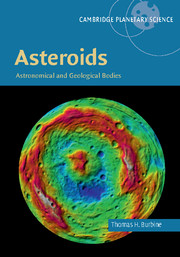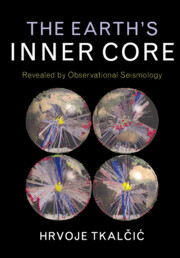Refine listing
Actions for selected content:
17002 results
3 - Inner Core Surface and Its Interior
-
- Book:
- The Earth's Inner Core
- Published online:
- 26 January 2017
- Print publication:
- 02 February 2017, pp 38-73
-
- Chapter
- Export citation
Acknowledgements
-
- Book:
- The Earth's Inner Core
- Published online:
- 26 January 2017
- Print publication:
- 02 February 2017, pp x-xii
-
- Chapter
- Export citation

Asteroids
- Astronomical and Geological Bodies
-
- Published online:
- 01 February 2017
- Print publication:
- 15 December 2016

The Earth's Inner Core
- Revealed by Observational Seismology
-
- Published online:
- 26 January 2017
- Print publication:
- 02 February 2017
Part Two - Chemical and Mineralogical Diversity
-
- Book:
- Planetesimals
- Published online:
- 25 February 2017
- Print publication:
- 26 January 2017, pp 69-266
-
- Chapter
- Export citation
15 - Dawn at Vesta: Paradigms and Paradoxes
- from Part Three - Asteroids as Records of Formation and Differentiation
-
-
- Book:
- Planetesimals
- Published online:
- 25 February 2017
- Print publication:
- 26 January 2017, pp 321-339
-
- Chapter
- Export citation
Part One - Dynamical Evolution
-
- Book:
- Planetesimals
- Published online:
- 25 February 2017
- Print publication:
- 26 January 2017, pp 5-68
-
- Chapter
- Export citation
Index
-
- Book:
- Planetesimals
- Published online:
- 25 February 2017
- Print publication:
- 26 January 2017, pp 376-381
-
- Chapter
- Export citation
2 - Signatures of Hit-and-run Collisions
- from Part One - Dynamical Evolution
-
-
- Book:
- Planetesimals
- Published online:
- 25 February 2017
- Print publication:
- 26 January 2017, pp 7-37
-
- Chapter
- Export citation
Copyright page
-
- Book:
- Planetesimals
- Published online:
- 25 February 2017
- Print publication:
- 26 January 2017, pp iv-iv
-
- Chapter
- Export citation
9 - Magnetic Fields on Asteroids and Planetesimals
- from Part Two - Chemical and Mineralogical Diversity
-
-
- Book:
- Planetesimals
- Published online:
- 25 February 2017
- Print publication:
- 26 January 2017, pp 180-203
-
- Chapter
- Export citation
Contributors
-
- Book:
- Planetesimals
- Published online:
- 25 February 2017
- Print publication:
- 26 January 2017, pp vii-xii
-
- Chapter
- Export citation
11 - Chronology of Planetesimal Differentiation
- from Part Two - Chemical and Mineralogical Diversity
-
-
- Book:
- Planetesimals
- Published online:
- 25 February 2017
- Print publication:
- 26 January 2017, pp 224-245
-
- Chapter
- Export citation
12 - Stable Isotope Evidence for the Differentiation and Evolution of Planetesimals
- from Part Two - Chemical and Mineralogical Diversity
-
-
- Book:
- Planetesimals
- Published online:
- 25 February 2017
- Print publication:
- 26 January 2017, pp 246-266
-
- Chapter
- Export citation
14 - Evidence for Differentiation among Asteroid Families
- from Part Three - Asteroids as Records of Formation and Differentiation
-
-
- Book:
- Planetesimals
- Published online:
- 25 February 2017
- Print publication:
- 26 January 2017, pp 298-320
-
- Chapter
- Export citation
1 - Planetesimals
-
-
- Book:
- Planetesimals
- Published online:
- 25 February 2017
- Print publication:
- 26 January 2017, pp 1-4
-
- Chapter
- Export citation
8 - Arguments for the Non-existence of Magma Oceans in Asteroids
- from Part Two - Chemical and Mineralogical Diversity
-
-
- Book:
- Planetesimals
- Published online:
- 25 February 2017
- Print publication:
- 26 January 2017, pp 159-179
-
- Chapter
- Export citation
7 - Iron and Stony-iron Meteorites: Evidence for the Formation, Crystallization, and Early Impact Histories of Differentiated Planetesimals
- from Part Two - Chemical and Mineralogical Diversity
-
-
- Book:
- Planetesimals
- Published online:
- 25 February 2017
- Print publication:
- 26 January 2017, pp 136-158
-
- Chapter
- Export citation
Part Four - Early Differentiation and Consequences for Planet Formation
-
- Book:
- Planetesimals
- Published online:
- 25 February 2017
- Print publication:
- 26 January 2017, pp 363-375
-
- Chapter
- Export citation
3 - Using the Main Asteroid Belt to Constrain Planetesimal and Planet Formation
- from Part One - Dynamical Evolution
-
-
- Book:
- Planetesimals
- Published online:
- 25 February 2017
- Print publication:
- 26 January 2017, pp 38-68
-
- Chapter
- Export citation
